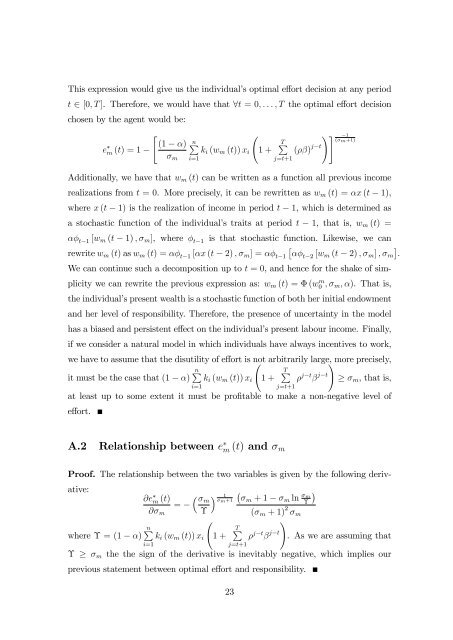You also want an ePaper? Increase the reach of your titles
YUMPU automatically turns print PDFs into web optimized ePapers that Google loves.
This expression would give us the individual’s optimal e¤ort decision at any period<br />
t 2 [0; T ]. Therefore, we would have that 8t = 0; : : : ; T the optimal e¤ort decision<br />
chosen by the agent would be:<br />
e m (t) = 1<br />
"<br />
(1 )<br />
m<br />
nP<br />
P<br />
k i (w m (t)) x i 1 + T<br />
i=1<br />
j=t+1<br />
() j t !# 1<br />
(m+1)<br />
Additionally, we have that w m (t) can be written as a function all previous income<br />
realizations from t = 0. More precisely, it can be rewritten as w m (t) = x (t 1),<br />
where x (t 1) is the realization of income in period t 1, which is determined as<br />
a stochastic function of the individual’s traits at period t 1, that is, w m (t) =<br />
t 1 [w m (t 1) ; m ], where t 1 is that stochastic function. Likewise, we can<br />
rewrite w m (t) as w m (t) = t 1 [x (t 2) ; m ] = t 1<br />
<br />
t 2 [w m (t 2) ; m ] ; m<br />
<br />
.<br />
We can continue such a decomposition up to t = 0, and hence for the shake of simplicity<br />
we can rewrite the previous expression as: w m (t) = (w m 0 ; m ; ). That is,<br />
the individual’s present wealth is a stochastic function of both her initial endowment<br />
and her level of responsibility. Therefore, the presence of uncertainty in the model<br />
has a biased and persistent e¤ect on the individual’s present labour income. Finally,<br />
if we consider a natural model in which individuals have always incentives to work,<br />
we have to assume that the disutility of e¤ort is not arbitrarily large, ! more precisely,<br />
P<br />
it must be the case that (1 ) n P<br />
k i (w m (t)) x i 1 + T j t j t m , that is,<br />
i=1<br />
j=t+1<br />
at least up to some extent it must be pro…table to make a non-negative level of<br />
e¤ort.<br />
A.2 Relationship between e m (t) and m<br />
Proof. The relationship between the two variables is given by the followi<strong>ng</strong> derivative:<br />
where = (1<br />
@e m (t)<br />
@ m<br />
=<br />
m<br />
<br />
P<br />
) n P<br />
k i (w m (t)) x i 1 + T<br />
i=1<br />
<br />
<br />
1<br />
m+1 m + 1 m ln m <br />
( m + 1) 2 m<br />
j=t+1<br />
j t j t !. As we are assumi<strong>ng</strong> that<br />
m the the sign of the derivative is inevitably negative, which implies our<br />
previous statement between optimal e¤ort and responsibility.<br />
23

















